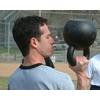Breathing Ladders
Rob Lawrence, RKC
July 17, 2002 10:12 AM
"Breathing ladders" are a very effective technique I've come up with for developing cardiovascular endurance. They are based on my observation, in karate training, that endurance is at least 50% mental. People who are out of shape tend to get in a panicked state as soon as they breathe a little hard. Not surprisingly, this rapidly makes the situation worse. Before they know it they're huffing and puffing and their technical skills go right to hell.
In karate they would often tell us to breathe calmly, but they did not show us any way of cultivating the skill. The breathing ladder is designed to do exactly that -- i.e. teach controlled breathing as a skill. The idea is to do a set, take a number of breaths (based on some ratio to the number reps you just did), then do the next set. For a simple example, let's look at a snatch breathing ladder with a 1:1 rep/breath ratio.
1. Do one snatch left, one snatch right, take two breaths.
2. Do two snatches left, two snatches right, take four breaths.
3. Do three snatches left, three snatches right, take sixth breaths.
4. Etc. ...
As you will rapidly discover, the way to survive is to slow your breath down as much as possible, to get maximum air and to increase your rest period between each set. If you panic and breathe quickly, your rest period is decreased and you are quickly dispatched to the dustbin of history. On the other hand, the only "timing" involved is your breath -- and the idea is to "cheat" as much as possible by drawing out the breaths and increasing the rest periods.
Of course, you can work with any ratio of reps/breaths that you prefer. If you're out of shape, you can work 1:2 or even 1:3; if you're in good shape, you can do 2:1, 3:1, or whatever.
The results of this training have been tremendous for me. When I teach my 45-minute kettlebell classes, I often do the workout with the students, not only doing the work, but instructing (and occasionally bellowing at) them as well, and never breathing hard. Needless to say, this tends to increase their impression that they should listen to me. I recommend this technique highly for instructors, or for anyone who needs to develop serious physical and mental endurance.

Back